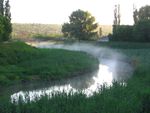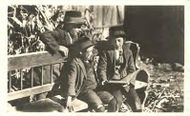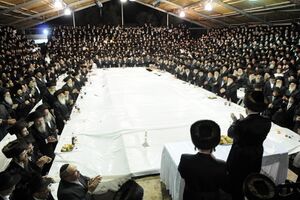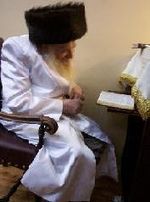اليهودية الحسيدية
| جزء من سلسلة مقالات عن |
| اليهود و اليهودية |
|---|
  |
| من هو اليهودي؟ • أصل الكلمة • الثقافة |
اليهودية الحسيدية، أو اليهودية القاصدية ([χasiˈdus]، بالإنگليزية: Hasidic Judaism)، هي حركة دينية يهودية نشأت كحركة نهضة روحية في أراضي غرب أوكرانيا المعاصرة، ثم پولندا، خلال القرن الثامن عشر، وسرعان ما انتشرت في جميع أنحاء شرق أوروپا. اليوم، يقيم معظم المنتمين إلى الحركة الحسيدية في إسرائيل والولايات المتحدة.
يعتبر إسرائيل بن إليعازر، "بعل شم طوڤ"، الأب المؤسس للحسيدية، وقام تلاميذه بتطويرها ونشرها. الحسيدية الحالية هي مجموعة فرعية داخل اليهودية الحريدية وتشتهر بمحافظتها الدينية وعزلتها الاجتماعية. يلتزم أعضاؤها بشكل وثيق بكل من الممارسة اليهودية الأرثوذكسية - مع التركيز الفريد للحركة - وتقاليد يهود شرق أوروپا. العديد من هذه التقاليد، بما في ذلك أنماط خاصة مختلفة من اللباس واستخدام اللغة اليديشية، ترتبط في الوقت الحاضر بشكل حصري تقريبًا بالحسيدية.
يعتمد الفكر الحسيدي بشكل كبير على القباله اللوريانية، وهو إلى حد ما تعميم لها. تؤكد التعاليم على وجود الرب في الكون، والحاجة إلى الانشقاق والاتحاد معه في جميع الأوقات، والجانب التعبدي للممارسة الدينية، والبعد الروحي للجسدية والأفعال الدنيوية. الحسيديون، أتباع الحسيدية، منظمون في طوائف مستقلة تُعرف باسم الأسر، يترأس كل منها زعيمها الوراثي الذكر، الزعيم الديني الحسيدي. إن التبجيل والخضوع للرب من المبادئ الأساسية، فهو يعتبر سلطة روحية يجب على المتبع أن يرتبط بها ليتقرب إلى الرب. تشترك "الأسر الحسيدية" المختلفة في قناعات أساسية، لكنها تعمل بشكل منفصل وتمتلك سمات وعادات فريدة. غالبًا ما يحافظ على الانتماء في العائلات لأجيال، ويعد كونك حسيديًا عاملاً اجتماعياً - يستلزم الولادة في مجتمع معين والولاء لأسرة زعيم ديني حسيدي- بقدر ما هو عاملاً دينياً. هناك عدة "أسر" تضم كل منها عدة آلاف من الأسر المعيشية، ومئات من الأسر الأصغر حجمًا. اعتبارًا من 2016، كان هناك أكثر من 130.000 أسرة حسيدية في جميع أنحاء العالم، أي حوالي 5% من السكان اليهود في العالم.
التاريخ

إسرائيل بن إلعازر
أنقذت الحركة الحسيدية اليهود الپولنديين بعض الإنقاذ من حالتهم الوضعية. وكان مؤسس "عقيدة التقوى" هذه إسرائيل بن ألعازر، المعروف باسم بعل شم-توب ("السيد الصالح لاسم الله")، واختصاراً باسم "بشت" الجامع لأول حروف اسمه الكامل. وكان يجوب البلاد معلماً للأطفال، وعاش في فقر تجمله البهجة، وكان يصلي بانتشاء ويشفي المرضى شفاء "معجزياً" بالأعشاب الجبلية. وقد طلب إلى أتباعه ألا يعيروا طقوس المجمع والمعرفة التلمودية كبير اهتمام، وأن يقتربوا إلى الله رأساً في شركة متواضعة ولكنها حميمة، وأن يبصروا الله ويحبوه في شتى صور الطبيعة ومظاهرها، في الصخور والأشجار، وفي حالات اليسر والألم؛ وأمرهم بأن يستمتعوا بالحياة في الحاضر بدلاً من البكاء على خطايا الماضي وآلامه. وكانت أقواله المأثورة البسيطة أحياناً تشبه أقوال المسيح. "شكا بشت أن ابنه ترك الله، وسأله قائلاً: يا معلم، ماذا أصنع؟ وأجابه بشت: أحبه أكثر مما فعلت في أي وقت". [1]

والحركة القاصدية في بولندة تقابل من بعض الوجوه حركات الأخوان الموابيين، والتقويين الألمان، والمثوديين الإنجليز؛ فقد اتفقت مع هذه الحركات على إخراج الدين من المعبد وإدخاله إلى القلب، ولكنها رفضت النسك والاكتئاب، وأمرت أتباعها بأن يرقصوا، ويستمتعوا بعناق أزواجهم، لا بل بالشراب بين الحين والحين إلى حد النشوة.
انتشار الحسيدية



المعارضة
ڤلنا گاعون والحسيدية الحبادية
 مقالة مفصلة: ڤلنا گاعون
مقالة مفصلة: ڤلنا گاعون
النزاع والحل
اندماج القرن 19 وتغيرات في المجتمع اليهودي


في الاتحاد السوڤيتي والهولوكوست


الديموغرافيا المعاصرة


The New York City Metropolitan Area is home to the largest American Hasidic population, with new towns in the Hudson Valley along with the original Brooklyn centers.
A Hasidic Jew supervising a construction site in Israel, where Hasidic groups differ over involvement in politics and society
Jewish district in Antwerp Belgium. Since the War, Pshevorsk leadership there remain the only major Hasidic dynasty in Europe
Former Bostoner Rebbe, and the mid-West USA Hornsteipl dynasty are examples of leadership in wider Jewish communities, like in the early Hasidic movement
الفكر الحسيدي

</ref> مفقود لوسم <ref>
الحكايات الحسيدية

الأفكار المميزة
أهداف الفكر القاصدي
الشعائر والثقافة الحسيدية
الطقوس والصلاة
Daily immersion
الملابس

غطاء الرأس
ملابس متميزة أخرى
الشعر
Tzitzis
النساء
الأسرات
اللغات

انظر أيضاً
الهوامش
- ^ ديورانت, ول; ديورانت, أرييل. قصة الحضارة. ترجمة بقيادة زكي نجيب محمود.
قراءات إضافية
- Balog, Yeshayahu; Morgenstern, Matthias (2010). Hasidism: A Mystical Movement Within Eastern European Judaism. Mainz: Institute of European History.
- Boteach, Shmuel (1993). Wisdom, understanding, and knowledge: basic concepts of hasidic thought. Northvale, New Jersey: Jason Aronson. ISBN 0-87668-557-2. LCCN 95006052.
{{cite book}}: Unknown parameter|month=ignored (help)
- Buber, Martin (July 23, 1991) [1947]. Tales of the Hasidim. translated by Olga Marx; foreword by Chaim Potok (Paperback: 2 volumes in 1 ed.). New York: Schocken Books. ISBN 0-8052-0995-6. LCCN 90052921.
- Chapin, David (2000). The Road from Letichev: The history and culture of a forgotten Jewish community in Eastern Europe, Volume 1. co-author Ben Weinstock. Lincoln, Nebraska: iUniverse. ISBN 0-595-00666-3.
- Dynner, Glenn (2006). Men of Silk: the Hasidic Conquest of Polish Jewish Society. New York: Oxford University Press. ISBN 0-19-517522-0.
- Finkel, Avraham Yaakov (1994). Contemporary sages: the great Chasidic masters of the twentieth century. Northvale, New Jersey: Jason Aronson. ISBN 1-56821-155-4. LCCN 94003078.
{{cite book}}: Unknown parameter|month=ignored (help)
- Nadler, Allan (June 24, 1997). The faith of the Mithnagdim: rabbinic responses to Hasidic rapture. Baltimore, Maryland: Johns Hopkins University Press. ISBN 0-8018-5560-8. LCCN 96006608.
- Rosman, Moshe (1996). Founder of Hasidism. Univ. of Calif. Press. ISBN 0-520-20191-4.
- Elior, Rachel. The Mystical Origins of Hasidism.
- Schochet, Elijah Judah (1994). The Hasidic Movement and the Gaon of Vilna. Northvale, New Jersey: Jason Aronson. ISBN 1-56821-125-2.
{{cite book}}: Unknown parameter|month=ignored (help) - Schacter-Shalomi, Zalman (2003). Wrapped in a Holy Flame. San Francisco, California: Jossey-Bass. ISBN 0-7879-6573-1.
- Buber, Martin (1948). Tales of the Hasidim: The Early Masters. San Francisco, California: Schocken Books. ISBN 0-8052-0995-6.
- Schochet, Jacob Immanuel, Rabbi Israel Baal Shem Tov (1961), Liebermann, Toronto, Canada
- Schochet, Jacob Immanuel, The Great Maggid (1974; 1990), Kehot, Brooklyn NY, ISBN 0-8266-0414-5
- Schochet, Jacob Immanuel, The Arrest and Liberation of Rabbi Schneur Zalman of Liadi (1964; 1992), Kehot, Brooklyn NY ISBN 0-8266-0418-8
- Schochet, Jacob Immanuel, Mystical Concepts in Chassidism (1979; 1988), Kehot, Brooklyn NY ISBN 0-8266-0412-9
- Schochet, Jacob Immanuel, The Mystical Tradition (1990; 1995), Kehot, Brooklyn NY ISBN 0-8266-0528-1
- Schochet, Jacob Immanuel, Deep Calling Unto Deep (1990; 1995), Kehot, Brooklyn NY ISBN 0-8266-0528-2 قالب:Please check ISBN
- Schochet, Jacob Immanuel, Chassidic Dimensions (1990; 1995), Kehot, Brooklyn NY ISBN 0-8266-0528-3 قالب:Please check ISBN
- Schochet, Jacob Immanuel, Tzava'at Harivash: The Testament of Rabbi Israel Baal Shem Tov (1998), Kehot, Brooklyn NY ISBN 0-8266-0399-8 (full text available online)
- Cecil Roth and Geoffrey Wigoder, ed. (1972). "Hasidic Judaism". Encyclopedia Judaica. Vol. 7. New York: Macmillan Company. LCCN 84214344.
- Volozhin, Reb Chayyim of, "The Soul of Life: The Complete Neffesh Ha-chayyim"[dead link] (2012), Amazon, ISBN 978-0615699912
- The Great Mission: The life and story of Rabbi Yisrael Baal Shem Tov. Compiled by Rabbi Eli Friedman, translated by Rabbi Elchonon Lesches. Kehot Publication Society, 2005, ISBN 0-8266-0681-4.
- Holy Days: The World of a Hasidic Family. Lis Harris. Simon & Schuster New York, 1985, ISBN 0-684-81366-1.
- Unchosen: The Hidden Lives of Hasidic Rebels. Hella Winston. Beacon Press Boston, 2005, ISBN 0-8070-3626-9.
- Souls on Fire: Portraits and Legends of Hasidic Masters. Elie Wiesel. Simon & Schuster New York, 1972, ISBN 0-671-44171-X.
- Hasidic People: A Place in the New World. Jerome R. Mintz. Harvard University Press, 1992.
وصلات خارجية
 "Chasidim". New International Encyclopedia. 1905.
"Chasidim". New International Encyclopedia. 1905.- Lecture on Mitnagdim, Hasidim and Maskilim by Dr. Henry Abramson
خرائط لانتشار القاصدية
- Map of the area of activity of the Baal Shem Tov, and the directions of the Maggid's students' dissemination
- Map of the spread of Hasidism from 1730 and 1760-75, and its encroachment on the Lithuanian centre of Rabbinic opposition
- Information on Orthodox Hasidic Jews
This template's initial visibility currently defaults to autocollapse, meaning that if there is another collapsible item on the page (a navbox, sidebar, or table with the collapsible attribute), it is hidden apart from its title bar; if not, it is fully visible.
To change this template's initial visibility, the |state= parameter may be used:
{{اليهودية الحسيدية|state=collapsed}}will show the template collapsed, i.e. hidden apart from its title bar.{{اليهودية الحسيدية|state=expanded}}will show the template expanded, i.e. fully visible.












